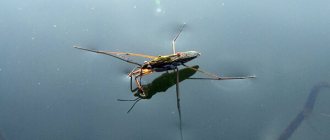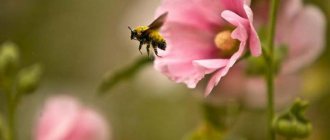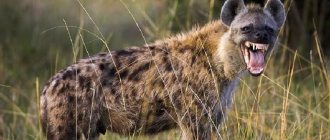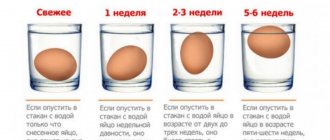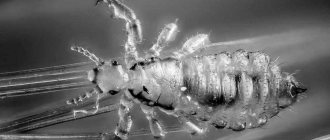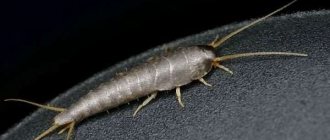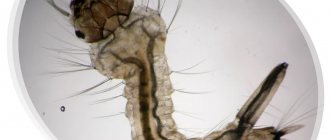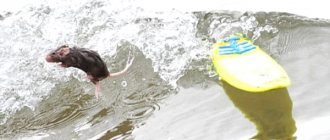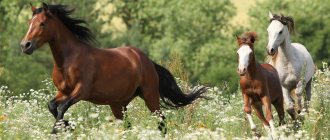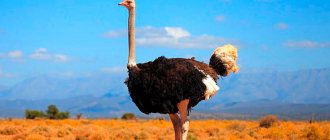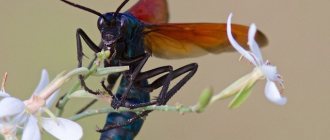02/28/2018 Category: Bedbugs Author: Irina Vasilyeva
If you have ever been on the banks of rivers with a slow flow, stagnant ponds or lakes, you have probably seen amazing insects on exorbitantly long, thin legs. They easily glide through the water, as if on an elastic film, deftly managing three pairs of legs. These are water striders, aquatic relatives of the large family of bugs.
- 2 Life expectancy, stages of development
- 3 What do water striders eat?
3.1 Video: how a water strider hunts
- 5.1 Video: why water striders don’t drown
Description and features
Water striders are a subspecies of the family of hemipteran bugs that live primarily on water. Thanks to the hard hairs covering the entire body of the insect, it does not sink in the water, but stays on its surface. These hairs have a water-repellent coating, which means they move quickly through water.
Water striders have three pairs of legs, the middle and hind ones are designed for movement and support, and the front ones are the shortest, help to hold prey and give direction to movement. In order to roll over, the insect uses three pairs of legs, moving them in all directions.
The body of insects is long and can reach 1-20 mm, color - from brown to dark brown. If obstacles arise on the water strider's road, they can jump, they have excellent vision and the ability to transmit and receive information using vibrations of the water surface.
Important! The antennae of the male are the most sensitive, thanks to this they easily and quickly find the female. Water striders live not only in ponds, but also in puddles. Interestingly, such species have wings, thanks to which they fly. River or lake specimens do not have them.
There are the following types of water striders:
- Large - their body length reaches 17 mm.
- Slow rod-shaped - they mainly live in Siberia, their body resembles a stick, hence the name.
- Pond - a distinctive feature is the bright coloring of the legs.
Water striders breathe atmospheric air, but unlike sea bugs, they do not need to swim to the surface of the water to rest, because. They live precisely on the surface of the reservoir. Their respiratory system is the trachea, into which air enters through stigmata. They are located on the sides of the mesothorax and metathorax, as well as on each abdominal segment.
Offspring
Aquatic arthropods reproduce by eggs. But their method of laying differs markedly. The female smoothie chooses the thickness of plant stems to lay eggs.
Paddlefish catch eggs with their offspring under deep algae or on other objects located under water.
Belostoma keeps future offspring under supervision all the time. The female lays eggs on the back of the male. There are usually so many eggs that its entire surface is filled.
A water bug with eggs on its back makes all movements (walks or swims). Before the appearance of the larvae, the future father is completely focused on caring for the offspring.
The male selects the required temperature regime for the eggs and offspring. Protects them from other predators, and also ensures that there is always good air circulation around the masonry.
During their life cycle, water bugs go through 3 main stages: egg, larva, and adult. The hatched larvae visually closely resemble adult individuals, but are significantly smaller in size.
Before the larvae transform into a full-fledged individual, several molts occur.
Interesting facts from the life of water striders
If insects have to fight for prey, then the tidbit goes to the most dexterous and fastest individual. She takes the victim to a secluded place while the rest of the bugs continue the fight, not noticing the disappearance of food.
A water strider can snatch someone else's prey from an opponent and hide in a secluded place.
It is interesting that in case of danger, as well as at night, water striders always try to hide in a southerly direction.
It is assumed that water striders can navigate by the sun.
Video: why water striders don't drown
For this purpose, bedbugs have small hairs on their legs, and the surfaces of their legs and abdomen are covered with a fatty component. If you're wondering why water striders don't drown, you can watch the video.
Ability to run on waves
The water strider is an insect whose description always boils down to a story about its amazing ability to withstand the water element. So how does she manage not to drown? The thing is that the bedbug's legs are covered with a special substance that resembles fat in its structure. This creates a kind of barrier that prevents the limbs from submerging in the water.
In addition, the insect knows how to correctly distribute weight: the load does not fall on one point, but is evenly transferred to all six limbs. As for the high speed of movement, it is achieved through fast, impulse strokes. It is they who create turbulence behind the water strider, which pushes it forward.
It is noteworthy that the bug can swim both on mirror-smooth surfaces and among waves. It is this skill that allows water striders to settle in various types of reservoirs, which significantly increases their survival rate, and, consequently, the population.
Water strider bug biological features and description
Water strider (lat. Gerridae) - represents the family of hemiptera (lat. Hemiptera), belongs to the order of bugs. The most common representative of the genus is the pond specimen (Gerris). It is familiar to every person who has visited the shore near the pond, its natural habitat. You can see it in more detail in the photo. The name speaks for itself, a small insect with long thin legs, very similar to a spider. The peculiarity is that it does not sink, its method of movement is sliding, it moves along its surface with incredible speed, it resembles a speed skater on perfectly flat ice.
Water strider bug description
There are about 700 species of water strider bugs in nature. Some of them are harmless, while others harm people, animals and plants. Externally, the insect's body resembles a thin stick from 1 to 30 mm long. The color is also varied, it varies from gray to dark brown. A distinctive feature is considered to be 3 pairs of long thin legs, thanks to which the bug does not drown. The front pair is the shortest, it is used to capture food and regulate the speed of movement. The hind legs are twice the length of the entire body; they are used to select the direction of movement and turns, and also help to jump over small obstacles. The middle legs simply participate in walking.
OUR READERS RECOMMEND! In the fight against bedbugs, our readers recommend the Pest-Reject repeller. Electromagnetic and ultrasonic technology is 100% effective against bedbugs, cockroaches and other insects. Absolutely safe, environmentally friendly product for humans and pets. Read more here...
The small head of the water strider bug is equipped with a long proboscis, with which it feeds. There are also antennae on the head, they are able to detect the slightest vibrations on the water surface, and large spherical eyes, which help in hunting and protection from enemies. Some individuals are equipped with thin scaly wings, thanks to this feature they can move short distances. This ability helps them during periods of drought when food is limited. If there are no wings, it always lives in the waters of one lake or river. After wintering, the winged representatives lose their wings, they dissolve and turn into a vital reserve, which serves as food after hibernation.
The habitat of the water strider bug depends on its variety. Most of them prefer fresh, standing water with plenty of vegetation.
Biological features of the water strider bug
Its life cycle is quite long and lasts one year. It begins with eggs, which the female lays on the leaves in the cavity of the vegetation, this stage lasts about two weeks, then within a month the larva grows and turns into an adult.
In cold weather, it hibernates and lives in thickets of aquatic vegetation or soil around its river. With the onset of warmth, life continues again, the process of reproduction begins.
A distinctive feature is that it does not sink, which is why it gets its name. The answer to the question why water strider bugs do not drown in water is very simple. This is due to the fact that its abdomen and paws are covered with a layer of fatty film and special villi. Their peculiarity is their ability to hold air bubbles and act like a lifebuoy. Thanks to the force of surface tension, the widely spaced fuzzy legs are held on the surface and prevent the owner from drowning.
What does the water strider bug eat?
The water strider is a predator; it feeds on small flies, mosquitoes and larvae, and harms the eggs of small fish, fry and clutches of foreign eggs. It grabs its prey with its tenacious front paws, uses its proboscis to inject it into the gastric juice, and then sucks out the digested contents; this feature of digestion makes them somewhat similar to spiders. The larvae feed in the same way. They often hunt in groups of 3-4 individuals, attacking large horse flies.
OUR READERS RECOMMEND! To get rid of BUGS, our readers recommend the Pest-Reject repeller. The operation of the device is based on the technology of electromagnetic pulses and ultrasonic waves! Absolutely safe, environmentally friendly product for humans and pets. Read more here...
Who eats water strider bugs
In nature, the water strider has two enemies that feed on it and cause particular harm to the population. These are fish and water mite larvae. The latter are especially dangerous; they attach themselves to the chest and suck out blood, leaving a red mark at the site of the bite. Fish are much less dangerous; they mainly feed on underwater animals and larvae.
Water strider bug harm and benefit
The harm and benefits of water meters are not commensurate with each other; they are a very important element in the ecosystem, are recognized as the main enemies of large blood-sucking horse flies, and play a leading role in regulating their population. Female horse flies that harm other animals lay eggs, and the bugs attack and destroy them. Another feature is that they feed on the remains of dead fauna, prevent them from rotting and cleanse the pond. These animals, unlike many terrestrial species, do not cause harm to the environment.
Why is the water strider bug dangerous?
Is it necessary to combat water striders that live in local rivers and lakes? Definitely not, they are so small and harmless that they do not pose any danger to people and do not harm animals and plants. There is a possibility of encountering one while swimming, because it does not sink in water, but it does not bite and you should not be afraid of it. The most dangerous thing for people to imagine is the bed bug.
Our users recommend
Life expectancy, stages of development
Mating occurs right on the water, in the warm season. A week after fertilization, females lay eggs on the stems or leaves of aquatic vegetation. The clutch of large species consists of a long ribbon of eggs glued together with mucus. Small ones lay single eggs, not treated with mucus.
Mating occurs on the water
Laying is carried out under the vigilant protection of the male. He jealously controls the surrounding space, scaring off potential enemies by hitting the water with his paws.
At one time, the female lays 40 to 50 eggs. They are whitish, cylindrical in shape, up to 1 mm in size. A week later, yellowish larvae (nymphs) emerge from the eggs, which gradually darken. The nymph resembles an adult (imago), but is more rounded.
The water strider larva is similar to the adult, but more rounded and smaller in size.
The larvae develop within a month, feeding on small insects. During this time, they go through 5 stages of development and end with molting. The folded abdomen, filled with food, straightens out.
The next breeding cycle occurs in mid-summer. At this time, insects of different ages are found in the reservoir.
Insects overwinter on the shore, finding a secluded place under stumps or in moss. Before this, they shed their wings, which no longer grow back after wintering. The full life cycle of water striders lasts a year.
Danger and benefit for humans
An insect water meter can disrupt the integrity of the integument of insects and even fish fry. Despite the fact that it has a piercing-sucking type of mouthparts, such a bug is capable of biting a person. But this will not be severe damage to the epidermis in the full sense. A bug bite in this case is an ordinary puncture. But at the time of insertion of the proboscis, unpleasant sensations may appear.
The bite itself poses no threat to humans. Even the risk of developing allergies is low.
Serious consequences do not appear. Bedbugs bite in self-defense if they feel threatened. They bring many benefits - they clean the pond of dead insects, and also help control the number of horseflies.
Water striders are not dangerous to people
General information about the species
It should be noted that this is a very common insect. The water strider lives almost everywhere, with the possible exception of the cold lands of the Arctic and Antarctic. Scientists classify these creatures as members of the family of hemiptera, a suborder of bedbugs. Today, more than 700 species of water striders are known, which differ not only in appearance and size, but also in their habitual way of life.
Notes
- [files.school-collection.edu.ru/dlrstore/50d0c166-f35a-4e14-8bf5-8545a19987ae/geris.htm Prudovaya Water Strider - Gerris Lacustris]
- [books.google.ru/books?id=PelhAAAAQBAJ&pg=PT84&lpg=PT84&dq=Gerris+lacustris+%D0%B2%D0%BE%D0%B4%D0%BE%D0%BC%D0%B5%D1%80%D0 %BA%D0%B0&source=bl&ots=XGNfQ6_Q7g&sig=F7Onkr0hBDXvNyYH7aWiuWXjTVs&hl=ru&sa=X&ei=jNTYU5qVEMWD4gS97IGYDQ&ved=0CFAQ6AEwCw#v=onepage&q=Gerris%20lacustris%20%D0%B2%D 0%BE%D0%B4%D0%BE%D0%BC %D0%B5%D1%80%D0%BA%D0%B0&f=false Life and customs of arthropods - Vladimir Polzikov - Google Books ]
- [animaldiversity.ummz.umich.edu/accounts/Gerris_lacustris/classification/ ADW: Gerris lacustris: CLASSIFICATION]
- ↑ 12
[www.itis.gov/servlet/SingleRpt/SingleRpt?search_topic=TSN&search_value=103846 ITIS Standard Report Page: Gerris lacustris] - [dic.academic.ru/dic.nsf/dic_biology/948/ Water striders]
- [www.naturespot.org.uk/species/water-measurer Water Measurer - Hydrometra stagnorum | NatureSpot]
- ↑ 12
[www.rspb.org.uk/wildlife/wildlifegarden/atoz/p/pondskater.aspx The RSPB: A to Z of a Wildlife Garden: Pond skater]
Is the water strider dangerous for humans?
These insects do not pose a danger to people. All their victims are small in size and have a different habitat. However, water bugs are not so harmless; if disturbed, they can sting. Their piercing apparatus is very sharp and can easily bite through human skin. But their bite does not harm the body.
A small red spot may form at the site of the bite, which is accompanied by slight itching. To relieve these sensations, the affected area must be lubricated with iodine. Tropical water striders pose a slight danger; an allergic reaction is possible as a result of their bite.
Traces on the code remain for several weeks, the affected area must be treated with special preparations, and also take antihistamines. The greatest damage that these insects can cause is eating rare varieties of fish, sucking out the contents of their bodies.
Water striders are aquatic insects that live in seas, rivers, lakes and even puddles. The unusual structure of water striders helps them cover long distances and hunt for prey. They do not pose a danger to people.
The lifespan of a water strider is about a year, during which time they breed offspring. Thanks to receptors on the antennae, the male quickly finds the female and fertilizes her.
Who are water striders?
These are small insects from the order Hemiptera. Simply put, these are bedbugs. Like their relatives, water striders are equipped with a piercing-sucking mouthparts (proboscis), which allows them to introduce special substances into the body of their prey that paralyze and decompose its tissues. This is necessary in order to suck the finished “broth” out of the victim.
Water striders are predatory creatures. Their main food is insects that accidentally fall on the surface of the water. If the future meal is large enough in size, then several water striders can feast on it at once. However, these creatures prefer to hunt and feed alone.
A little physics
Before revealing the secret of water striders, it is necessary to remember some basics of the physical properties of water. As is known, the air and water environments are separated from each other by a special film of surface tension. At the boundary of two phases, the attractive forces arising between water molecules are not balanced, i.e. the sum of forces acting downwards turns out to be many times greater than the sum of forces acting upwards. Due to this, the density of water on the surface of the reservoir is slightly higher than in the main water layer.
But that is not all! Molecules tending downward lead to the appearance of a kind of elastic membrane that is capable of supporting objects with a density higher than this on the surface of the water. However, there is one condition: these objects must be dry. If you wet them, they will independently attract water molecules to themselves, which will disrupt the structure of the surface film.
It is curious that various living organisms use these amazing physical properties of the water film for their own purposes. It is worth moving from physics to zoology. As you know, life on the border of two habitats has a very noticeable advantage. The most famous inhabitants of the surfaces of reservoirs are, of course, water striders.
Nutritional Features
Water striders are excellent hunters. They have acute vision and well-developed receptors that respond to movement. These receptors are located on the antennae and limbs of the bug, and therefore the animal reacts very quickly to fluctuations in water. Its reaction to the movement of prey is almost instantaneous, and therefore it is quite easy for the water strider to get food. Despite its size, this animal is a serious predator. The diet consists of a large number of different insects and other representatives of the animal world, similar in size.
To catch prey, the insect uses its front legs, which are equipped with hooks that allow them to hold food tightly. When eating, the animal uses a long proboscis, which is located under the chest the rest of the time. The bug stabs it into its prey to inject venom and suck out nutrients.
The following animals become victims of the water strider:
- Flying insects, for example, flies and horseflies. They only occasionally enter the diet of bedbugs. Sometimes insects fly too low over the water and fall into it.
- Eggs of other types of insects, fish eggs. Quiet creeks and marshy shores abound with such food.
- Jellyfish and fry. Only water striders living on the surface of seas and oceans can feed on these animals.
- Animal remains. Water striders willingly eat various carrions, thus clearing the banks and reservoirs of the decaying remains of representatives of the local fauna.
Portrait in a water interior
The appearance of aquatic insects is very different from their land relatives. The body of the water strider is long, elongated, resembles a boat or a stick, ranging in size from 1 to 3 centimeters.
The color is dim, from light gray or greenish to dark brown. The lower part of the back usually has a speckled pattern. Most species have membranous wings hidden under hard elytra.
Three pairs of legs are different in length, the middle and back are one and a half to two times larger than the size of the body. The front legs are the shortest and are used to regulate the speed of movement, as well as to capture and hold prey.
The middle and rear ones resemble oars or skis; they hold the bug on the water, are used for sliding and turning, and sometimes for jumping. All paws are equipped with small hairs-villi.
The head is small, with large round eyes and antennae that detect vibrations in air and water. The insect uses them for touch and smell.
The oral apparatus is a sharp, jointed proboscis. With its help, the water strider pierces the victim's body and sucks out nutrients.
About 700 species of these insects are now known. Common for Russian reservoirs is Prudovaya (Gerris lacustris). There are also Big (Gerris rufoscutellatus), Armored (Gerris thoracicus), Velia (Velia currens), Stick (Hydrometra gracilenta). The largest species found on our territory is Bolshaya, reaches 1.7 cm in length, the most cold-resistant - Velia lives in the northern regions and can settle in cold springs. The rod has a narrow, elongated body, is common in Siberia, and moves its legs alternately when moving. This is the slowest water strider.
How to fight
Since the water bug does not pose a danger or threat to human life, it is not necessary to fight it. He never attacks first. If a person accidentally steps on it or picks it up, the insect may bite in defense.
The damaged area resembles a wasp sting, leaving redness and swelling. The affected area can be lubricated with brilliant green or insect bite gel to relieve itching.
On the contrary, water bugs provide some benefits. Since they live in water, they feed on the larvae of horseflies, spiders, mosquitoes and other blood-sucking insects.
If an insect somehow ends up in the room, you should not pick it up with your bare hands. It's better to wear gloves or sweep with a broom.
The only harm insects of this family can cause is to the farm. By feeding on fry, they can destroy valuable fish species.
To know what certain types of water bugs look like, you can look at the photo.
Can you imagine a bug up to 10 cm long that lives in water and is capable of eating a turtle? Water striders and other water bugs look more harmless. Should you beware of them and what kind of danger do they pose?
In slow-moving or stagnant waters, you can often find insects that move along the surface on long legs. We call these representatives of the fauna water striders. But for many it will be a discovery that they belong to the suborder of bedbugs. And these are far from the only representatives of hemipterans. He doesn't look like him at all!
Their way of life
A large number of well-known species of water striders live in reservoirs: large, armored, velia, stick, small, etc. The large water strider reaches a length of about 17 mm. She has wings and a reddish body. Pond species about 1 cm long. It has a dark brown color, light legs, and black stripes on the front legs. At the same time, female pond snails have a red abdomen, and males have a black one.
The marine species is 5 mm smaller, but can move at speeds of up to 3.5 km/h. It lives in the Indian and Pacific Oceans and feeds on fish eggs. Insects are found in open water, often several kilometers from land. Scientists also found out where the water strider bug lives. It lives in bodies of water with a lot of vegetation. In this case, most often, water striders choose stagnant water, which has a very weak current. They spend most of their lives on the surface of the water. There are also winged species that, if desired, can move to other bodies of water. Wingless individuals do not change location.
Their life is short and lasts only one year. Parasites are not dangerous to humans. They bite, but these bites are not poisonous, although they are painful. People usually come into contact with them while swimming in bodies of water. The favorite places of insects are human toes and hands.
It is worth knowing what the water strider bug feeds on in the pond. Their usual food is fish fry or insects that have fallen into the pond. Parasites have piercing-sucking mouthparts. Using the trunk, they introduce an enzyme into the body of the fry, which dissolves all organs and tissues, after which it absorbs the resulting mass. However, there are those who like to feed on small bugs, water striders. Among them are herons and frogs. You can easily find a video of a frog happily eating water strider bugs.
How do insects reproduce?
During reproduction, insects lay eggs several times, and according to a certain pattern. The female places them in a single row on the surface of plants growing in water bodies. At the same time, the water strider secretes mucus, with the help of which it attaches the eggs not only to the leaves, but also to each other. From a distance, a clutch of eggs, the number of which can be up to 50, resembles a long light cord.
During laying, a male is constantly near the female. He ensures her safety and peace. Parasites reproduce all summer, and their larvae are similar to adults, only small in size.
During the mating season, males are very jealous of their territory and do not allow other males to approach the female. When an opponent appears, they begin to hit the water surface with their paws. Scientists claim that insects are able to control a large area in order to prevent a meeting with a so-called competitor. The male easily recognizes the sliding of his female through the water, so he will not attack her.
Interesting facts about parasites
There are some interesting facts about water strider bugs. For example, many are interested in the answer to the question of why small water strider bugs do not drown in water. The fact is that the long legs of the insect are covered with tiny hairs. They trap air, so they help him maintain balance. In addition, their abdomen is lubricated with a wax-like liquid. It repels water and prevents the water strider from drowning. It was also noticed that insects located among a large number of air bubbles look silvery. When winter comes, parasites begin to prepare for the winter, which they spend on land. During this time, the muscles that control the wings atrophy. This is the answer to why water strider bugs become wingless during the cold season.
Some time ago, scientists established another feature of these insects. It turned out that they affect the reduction of the horsefly population. The fact is that horseflies lay their eggs in bodies of water where their larvae develop. Water striders feed on both fly larvae and adults. Moreover, an adult horsefly is too large for one insect, so it is usually attacked by several bugs at once. It was found that one bug will suck a horsefly for about an hour, while a flock will take only a few minutes.
The respiratory organs of parasites are presented in the form of tubes. The respiratory system is located in the front of the abdomen, but insects cannot breathe under water. To capture air, they have to surface.
Why do you dream about parasites?
Sometimes questions arise not only regarding who eats the water strider bug, but also why they dream. There are several authoritative dream books that can help solve the dream. These insects are very unpleasant, so many people believe that a dream with their participation warns of various troubles. Dream Interpretations agree with this opinion.
For example, Miller’s dream book claims that bedbugs in a dream are a harbinger of a long illness and other misfortunes. If there were a lot of them, it means that in reality some event will radically change your destiny. Seeing dead insects means misfortune that will arise due to some disease. Squashing parasites that produce water instead of blood indicates an accident that will happen soon. Bugs crawling on a white wall mean a disease with a quick cure. According to the Small Velesov Dream Book, parasites dream of trouble, boredom, annoying people who force you to communicate with yourself from time to time, but do not cause much interest. The source also claims that parasites can predict material well-being, but most likely it will appear only after serious and long work, which was accompanied by great hassle. But this prediction is only valid if you simply watch the crawling insects. If you have to look for them, it means that soon you will have unpleasant troubles and significant expenses. According to the publication, an eaten bug could mean a scandal or quarrel in the near future.
A similar interpretation is given by the dream book of Simon Kananit, who claims that bedbugs foretell a meeting with an annoying, unpleasant acquaintance. Allegedly, this person will drain positive energy from you the same way bedbugs drink blood. The dream book of birthday people for January-April agrees with this prediction. He says that parasites indicate the presence of an energy vampire near you
The love dream book claims that seeing bedbugs means impending troubles with your loved one. It is possible that he will lie to you a lot and show his two-faced nature. A large number of parasites is a harbinger of betrayal or an impartial act on the part of a partner.
Return to description

